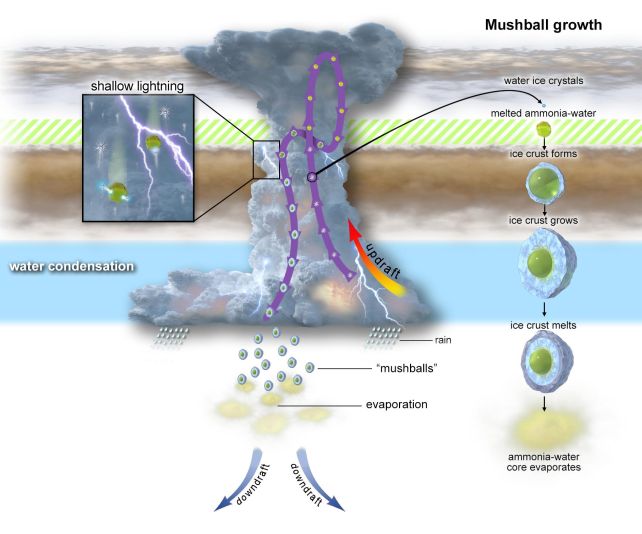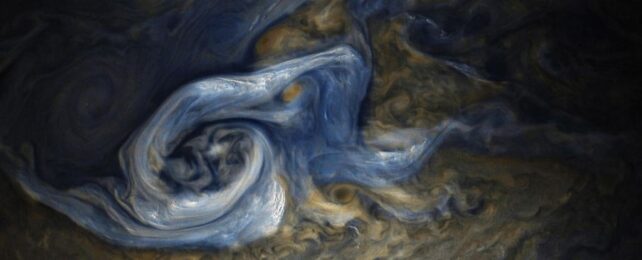Weather on Jupiter may have some surprising similarities to Earth phenomena, but some things it does defy easy explanation.
Now, scientists have come up with one to explain the strange compositional properties of its wild clouds: during giant storms of thunder and lightning, Jupiter rains a hail of "mushballs", huge clumps of mushy ice consisting of ammonia and water, with a consistency like wet snow or a convenience store slushee.
It's the best scenario astronomers have come up with to explain why Jupiter's atmosphere – and those of Saturn, Uranus, and Neptune – have such a patchy distribution of ammonia.
"Imke [de Pater] and I both were like, 'There's no way in the world this is true,'" says planetary scientist Chris Moeckel of the University of California (UC) Berkeley, who led the research. "So many things have to come together to actually explain this, it seems so exotic. I basically spent three years trying to prove this wrong. And I couldn't prove it wrong."
The hypothesis first emerged in 2020, when scientists studying data from Jupiter probe Juno suggested a peculiar mechanism for the extraction of ammonia and water from the planet's upper atmosphere.
Jupiter's massive storms, they proposed, eject water high above the planet's water clouds, where they encounter ammonia vapor that melts the ice. Then, the water and ammonia freeze together in the extreme cold.
"At these altitudes, the ammonia acts like an antifreeze, lowering the melting point of water ice and allowing the formation of a cloud with ammonia-water liquid," planetary scientist Heidi Becker of NASA' s Jet Propulsion Laboratory explained at the time.
"In this new state, falling droplets of ammonia-water liquid can collide with the upgoing water-ice crystals and electrify the clouds. This was a big surprise, as ammonia-water clouds do not exist on Earth."

To investigate whether this is even possible, Moeckel and his colleagues, Imke de Pater of UC Berkeley and Huazhi Ge of Caltech, pored over data collected by Juno and the Hubble Space Telescope in July 2017, as the probe flew over a giant lightning storm that is still raging to this day.
Juno took recordings in six different radio frequencies with its microwave radiometer instrument, while Hubble made observations across ultraviolet, optical, and near-infrared wavelengths.
Jupiter's atmosphere is pretty wild, with multiple storms unlike anything on Earth raging at any given time. Most of the weather, however, is relatively shallow. In a preprint currently undergoing peer review, Moeckel, de Pater, and a separate team describe the 3D structure of the upper atmosphere, revealing that most of the weather systems only extend 10 to 20 kilometers (6.2 to 12.4 miles) below the visible cloud tops.
Some weather systems, however, plunge much deeper into the troposphere, such as cyclonic vortices, ammonia-rich cloud bands, and the violent lightning storms in which the mushballs emerge.
"Every time you look at Jupiter, it's mostly just surface level. It's shallow, but a few things – vortices and these big storms – can punch through," Moeckel says. "We're basically showing that the top of the atmosphere is actually a pretty bad representative of what is inside the planet."
These mushball storms effectively unmix the upper atmosphere. The mushballs form and they fall, depleting the atmosphere of ammonia down to about 150 kilometers, but transporting it deeper into the planetary interior.

Previously, scientists had no idea what had removed the ammonia. Mushballs explain it perfectly. Water starts its journey deep in the clouds before being flung upwards, meeting with ammonia, and mixing in a ratio of around three parts water to one ammonia. The mixed blobs freeze and fall deep into Jupiter, where they evaporate and deposit their contents.
This requires really specific conditions, such as extremely strong updrafts to carry the water, and extremely rapid mixing so that the mushballs can form and grow large enough to survive raining back down into Jupiter's atmosphere. The smoking gun was one signal in the Juno radio data.
"There was a small spot under the cloud that either looked like cooling, that is, melting ice, or an ammonia enhancement, that is, melting and release of ammonia," Moeckel says. "It was the fact that either explanation was only possible with mushballs that eventually convinced me."
This transport mechanism is unlikely to be unique to Jupiter. Scientists have hypothesized that similar mechanisms might be at play on all the giant planets in the Solar System, and beyond. Let's hope future observations can find them.
The research has been published in Science Advances.
